2017 MITSUBISHI iMiEV light
[x] Cancel search: lightPage 29 of 296
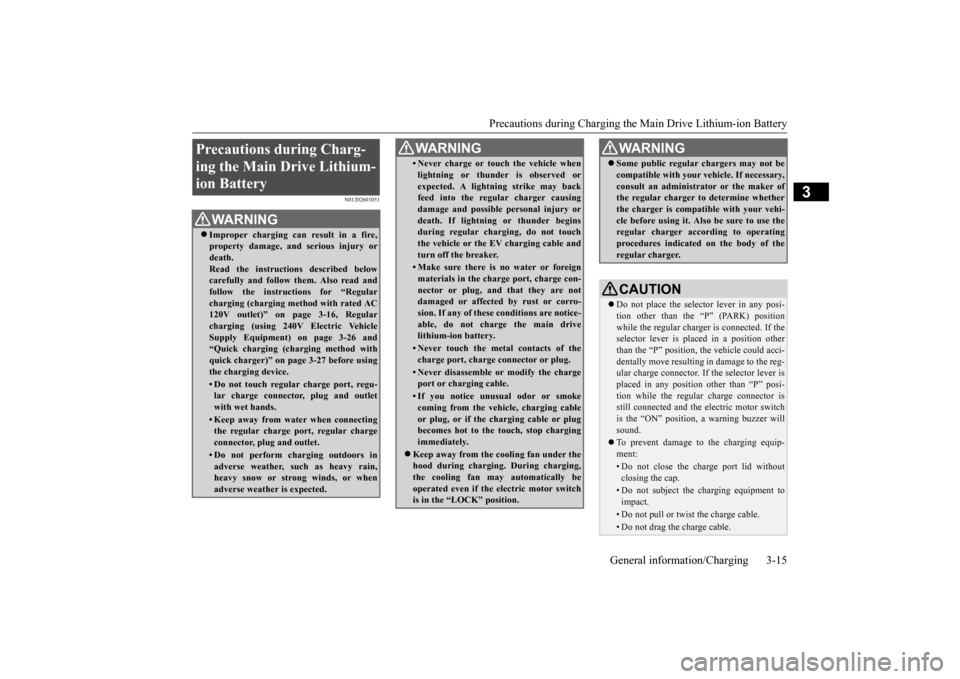
Precautions during Charging the
Main Drive Lithium-ion Battery
General information/Charging 3-15
3
N01202601051
Precautions during Charg- ing the Main Drive Lithium-ion Battery
WA R N I N G Improper charging can result in a fire, property damage, and serious injury ordeath. Read the instructions described below carefully and follow them. Also read andfollow the instructions for “Regular charging (charging method with rated AC 120V outlet)” on page 3-16, Regularcharging (using 240V
Electric Vehicle
Supply Equipment)
on page 3-26 and
“Quick charging (c
harging method with
quick charger)” on p
age 3-27 before using
the charging device.• Do not touch regular charge port, regu-lar charge connecto
r, plug and outlet
with wet hands.• Keep away from wate
r when connecting
the regular charge port, regular chargeconnector, plug and outlet.• Do not perform charging outdoors inadverse weather, su
ch as heavy rain,
heavy snow or strong winds, or when adverse weather is expected.
• Never charge or to
uch the vehicle when
lightning or thunde
r is observed or
expected. A lightning strike may backfeed into the regular charger causing damage and possible
personal injury or
death. If lightnin
g or thunder begins
during regular charging, do not touch the vehicle or the EV
charging cable and
turn off the breaker.• Make sure there is no water or foreignmaterials in the char
ge port, charge con-
nector or plug, and that they are not damaged or affected by rust or corro- sion. If any of these conditions are notice-able, do not charge
the main drive
lithium-ion battery.• Never touch the metal contacts of thecharge port, charge
connector or plug.
• Never disassemble or modify the charge port or charging cable.• If you notice unus
ual odor or smoke
coming from the vehicle, charging cable or plug, or if the ch
arging cable or plug
becomes hot to the touch, stop charging immediately.
Keep away from the cooling fan under the hood during charging. During charging, the cooling fan m
ay automatically be
operated even if the electric motor switch is in the “LOCK” position. WA R N I N G
Some public regular chargers may not be compatible with your vehicle. If necessary,consult an administrator or the maker ofthe regular charger to determine whether the charger is compat
ible with
your vehi-
cle before using it. Also be sure to use theregular charger acco
rding to operating
procedures indicated on the body of the regular charger.CAUTION Do not place the select
or lever in any posi-
tion other than the “P” (PARK) positionwhile the regular charger is connected. If the selector lever is plac
ed in a position other
than the “P” position, the vehicle could acci-dentally move resulting in damage to the reg- ular charge connector. If
the selector lever is
placed in any position other than “P” posi-tion while the regular charge connector is still connected and the
electric motor switch
is the “ON” position,
a warning buzzer will
sound. To prevent damage to the charging equip- ment:• Do not close the charge port lid withoutclosing the cap.• Do not subject the charging equipment toimpact.• Do not pull or twist the charge cable.• Do not drag the charge cable.WA R N I N G
BK0220401US.book 15 ページ 2015年6月3日 水曜日 午前7時42分
Page 31 of 296

Regular charging (charging method with rated AC 120 V outlet)
General information/Charging 3-17
3
N01216200019
Regular charge port light (A) comes on when the UNLOCK button on the remote control transmitter is pressed, or when any door orthe liftgate is opened.
The regular charge port
light and the dome light
s (with the dome light
switch in the “DOOR” position) will come onsimultaneously. However, the regular charge port light will not
come on when you press
the dome light (front) lens or slide the dome light (rear) switch to the “ON” position. For details, refer to
“Keyless entry system”
on page 5-5, “Dome
light (Front)/Reading
lights” on page 5-77 a
nd “Dome light (Rear)”
To turn on the charge port light again, press the UNLOCK button on the remote control transmitter, or open any
door or the liftgate.
Individuals using an
electro-medical
apparatus such as implantable pacemak-ers and implantable
cardiovascular-defi-
brillators should
check with the
manufacturer of the apparatus to confirm the effect of the el
ectromagnetic waves
from charging. The el
ectromagnetic waves
may affect the operations of the electro- medical apparatus. If you use an electro-medical apparatus, such as an implanta
ble cardiac pacemaker
or an implantable ca
rdiovascular
defibril-
lator, observe the following precautions before charging;• Keep your electro-medical apparatusaway from the charge connector, EVcharging cable, control box and regular charging station.• While regular charging;· Do not stay inside the vehicle. · Do not go inside the vehicle, for exam- ple to remove or place an item in the passenger compartment.· Do not open the liftgate, for example to remove or place an item in the cargo area.
To reduce the risk of electric shock, con- nect only to a prop
erly grounded and
waterproofed outlet. Never use an extension cable, multi-plug adapter or conversion adapter. Using them may cause overheating result- ing in fire.WA R N I N G
Never force the connection if the charging cable or plug shows damage or is not eas-ily connected due to foreign materialentering the plug or the outlet. Never use an outlet that is worn, damaged, or will not hold the plug firmly. Make sure that the plug is inserted all the way into the outlet before use. While it is normal fo
r the plug and charg-
ing cable to become warm during charg- ing, discontinue use immediately if the plug or charging cable becomes too hot totouch. Never pull the cable to remove the plug.Never connect or disconnect the plug with a wet hand.NOTE
Your vehicle is equipped with an EV charg- ing cable for regular charging. Refer to “EVcharging cable” on page 3-23. When connecting or
disconnecting the regu-
lar charge connector, in
sert/pull out the con-
nector straight. Also, do not incline or twist the connector.Doing so could cause a bad connection ormalfunction. Make sure to lock the doors to prevent theft, etc. during charging.WA R N I N G
Regular charge port light
A
BK0220401US.book 17 ページ 2015年6月3日 水曜日 午前7時42分
Page 32 of 296
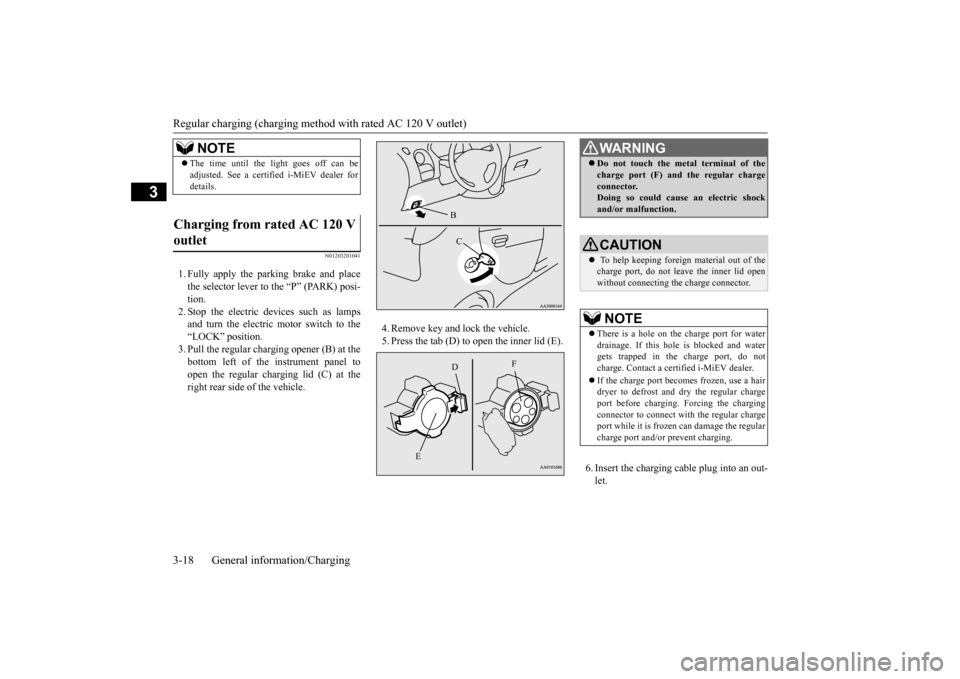
Regular charging (charging method with rated AC 120 V outlet)
3
N01203201041
1. Fully apply the parking brake and place the selector lever to the “P” (PARK) posi- tion. 2. Stop the electric devices such as lampsand turn the electric motor switch to the “LOCK” position. 3. Pull the regular charging opener (B) at thebottom left of the instrument panel to open the regular charging lid (C) at the right rear side of the vehicle.
4. Remove key and lock the vehicle. 5. Press the tab (D) to open the inner lid (E).
6. Insert the charging cable plug into an out- let.
NOTE
The time until the light goes off can be adjusted. See a certified i-MiEV dealer fordetails.
Charging from rated AC 120 V outlet
B C
F
D
E
WA R N I N G Do not touch the metal terminal of the charge port (F) an
d the regular charge
connector.Doing so could cause an electric shock and/or malfunction.CAUTION To help keeping forei
gn material out of the
charge port, do not leave the inner lid openwithout connecting th
e charge connector.
NOTE
There is a hole on the charge port for water drainage. If this hole
is blocked and water
gets trapped in the charge port, do not charge. Contact a certified i-MiEV dealer. If the charge port becomes frozen, use a hair dryer to defrost and dry the regular chargeport before charging. Forcing the charging connector to connect w
ith the regular charge
port while it is frozen
can damage the regular
charge port and/or prevent charging.
BK0220401US.book 18 ページ 2015年6月3日 水曜日 午前7時42分
Page 38 of 296
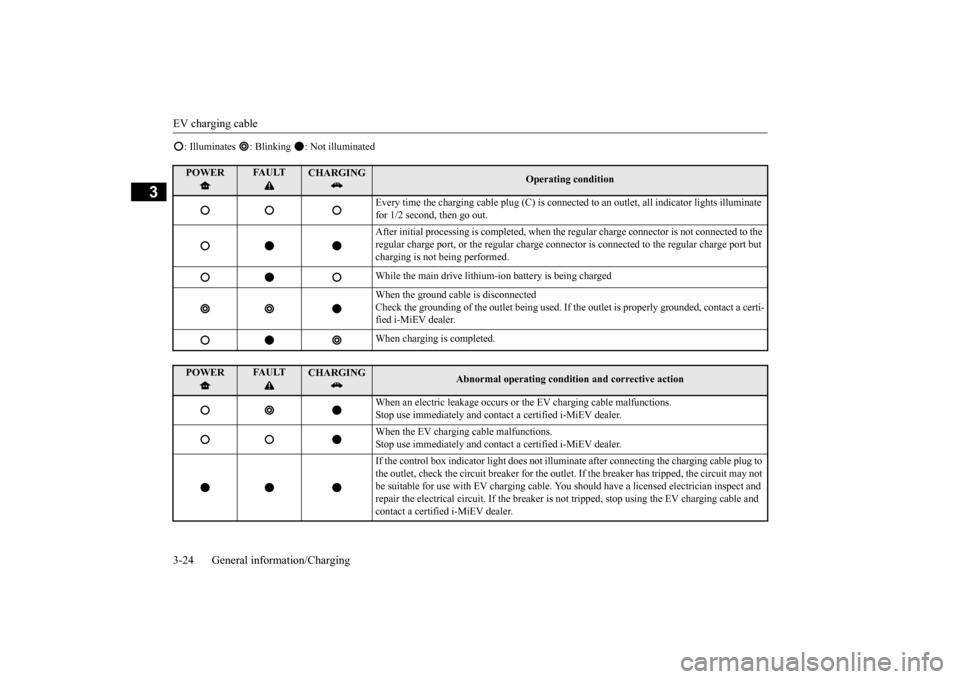
EV charging cable 3-24 General information/Charging
3
: Illuminates : Blinking : Not illuminatedPOWER
FAULT
CHARGING
Operating condition
Every time the charging cable plug (C) is connected
to an outlet, all indicator lights illuminate
for 1/2 second, then go out. After initial processing is comple
ted, when the regular charge c
onnector is not connected to the
regular charge port, or the regular charge connec
tor is connected to the regular charge port but
charging is not being performed. While the main drive lithium-i
on battery is being charged
When the ground cable is disconnected Check the grounding of the outlet being used. If
the outlet is properly gr
ounded, contact a certi-
fied i-MiEV dealer. When charging is completed.
POWER
FAULT
CHARGING
Abnormal operating conditi
on and corrective action
When an electric leakage occurs or the EV charging cable malfunctions. Stop use immediately and contac
t a certified i-MiEV dealer.
When the EV chargi
ng cable malfunctions.
Stop use immediately and contac
t a certified i-MiEV dealer.
If the control box indicator light
does not illuminate after connect
ing the charging cable plug to
the outlet, check the circuit breaker for the outlet.
If the breaker has tripped, the circuit may not
be suitable for use with EV charging cable. Y
ou should have a licensed
electrician inspect and
repair the electrical circuit. If the breaker is
not tripped, stop using the EV charging cable and
contact a certifie
d i-MiEV dealer.
BK0220401US.book 24 ページ 2015年6月3日 水曜日 午前7時42分
Page 45 of 296
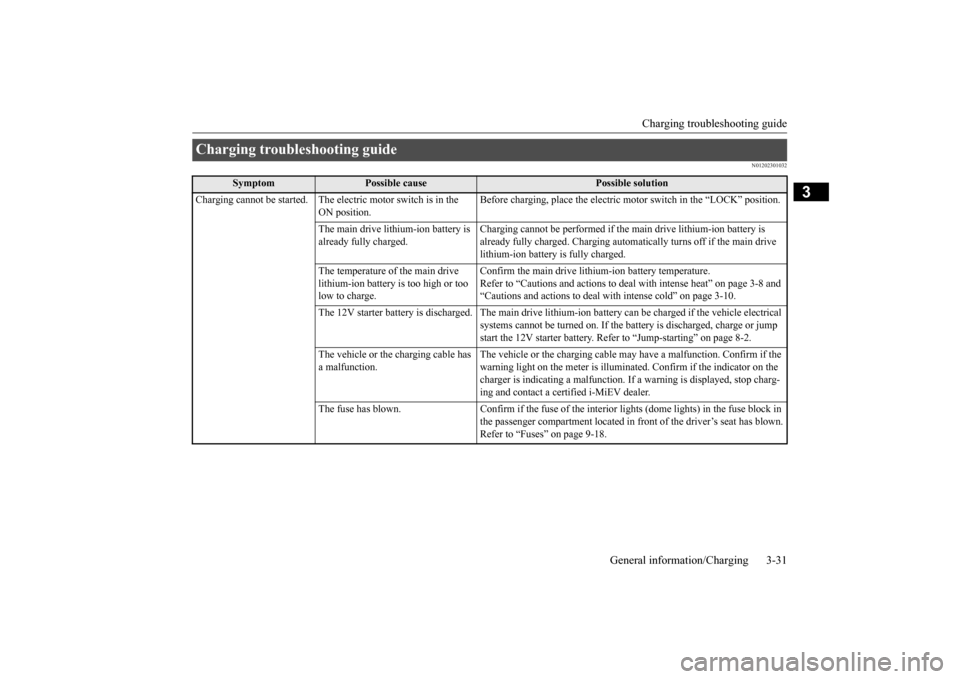
Charging troubleshooting guide
General information/Charging 3-31
3
N01202301032
Charging troubleshooting guide
Symptom
Possible cause
Possible solution
Charging cannot be started. The elec
tric motor switch is in the
ON position.
Before charging, place the electric motor switch in the “LOCK” position.
The main drive lithium-ion battery is already fully charged.
Charging cannot be performed if the
main drive lithium-ion battery is
already fully charged. Charging automa
tically turns off if the main drive
lithium-ion battery is fully charged.
The temperature of the main drive lithium-ion battery is too high or too low to charge.
Confirm the main drive lithium-ion battery temperature. Refer to “Cautions and actions to deal
with intense heat” on page 3-8 and
“Cautions and actions to deal with intense cold” on page 3-10.
The 12V starter battery is discharged. The main drive lith
ium-ion battery can be charge
d if the vehicle electrical
systems cannot be turned on. If the batte
ry is discharged, charge or jump
start the 12V starter battery. Refer
to “Jump-starting” on page 8-2.
The vehicle or the charging cable has a malfunction.
The vehicle or the charging cable ma
y have a malfunction. Confirm if the
warning light on the meter is illuminated. Confirm if the indicator on the charger is indicating a malfunction. If
a warning is displayed, stop charg-
ing and contact a cer
tified i-MiEV dealer.
The fuse has blown. Confirm if the fuse of the in
terior lights (dome lights) in the fuse block in
the passenger compartment located in front of the driver’s seat has blown. Refer to “Fuses” on page 9-18.
BK0220401US.book 31 ページ 2015年6月3日 水曜日 午前7時42分
Page 50 of 296
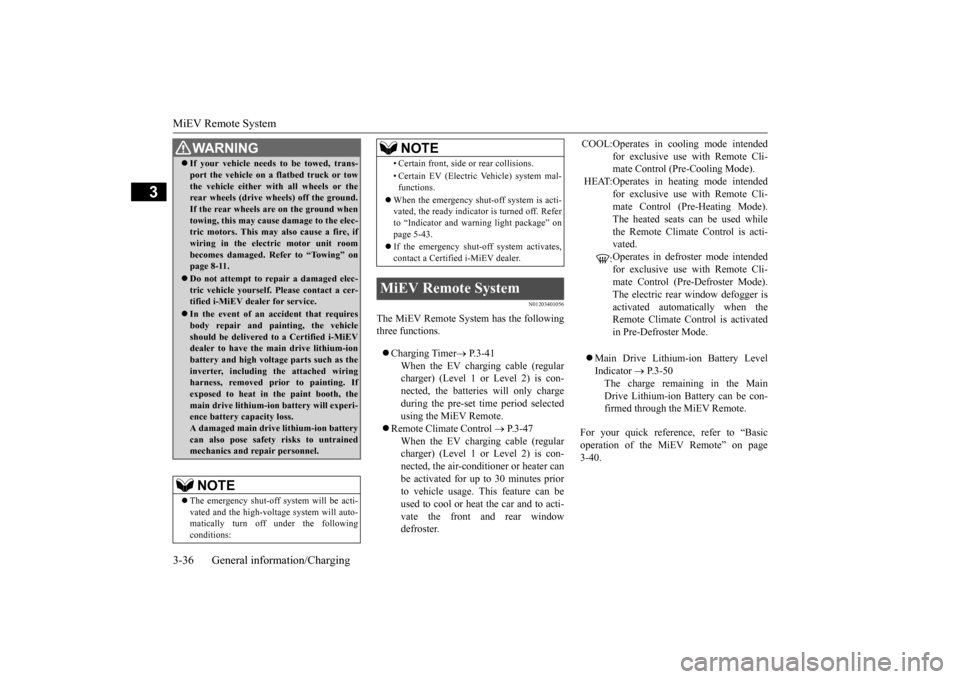
MiEV Remote System 3-36 General information/Charging
3
N01203401056
The MiEV Remote System has the following three functions. Charging Timer
P.3-41
When the EV charging cable (regular charger) (Level 1 or Level 2) is con-nected, the batteries will only charge during the pre-set
time period selected
using the MiEV Remote.
Remote Climate Control
P.3-47
When the EV charging cable (regular charger) (Level 1 or Level 2) is con-nected, the air-conditi
oner or heater can
be activated for up to 30 minutes prior to vehicle usage. This feature can beused to cool or heat the car and to acti- vate the front and rear window defroster.
Main Drive Lithium-ion Battery Level Indicator
P.3-50
The charge remaining in the Main Drive Lithium-ion Battery can be con-firmed through the MiEV Remote.
For your quick reference, refer to “Basic operation of the MiEV Remote” on page 3-40.
If your vehicle needs to be towed, trans- port the vehicle on a
flatbed truck or tow
the vehicle either with all wheels or therear wheels (drive
wheels) off the ground.
If the rear wheels are on the ground when towing, this may cause damage to the elec-tric motors. This may also cause a fire, if wiring in the electric motor unit room becomes damaged. Refer to “Towing” onpage 8-11. Do not attempt to repair a damaged elec- tric vehicle yourself. Please contact a cer- tified i-MiEV dealer for service. In the event of an ac
cident that requires
body repair and painting, the vehicle should be delivered
to a Certified i-MiEV
dealer to have the main drive lithium-ion battery and high voltage
parts such as the
inverter, including the attached wiringharness, removed prior to painting. If exposed to heat in the paint booth, the main drive lithium-ion battery will experi-ence battery capacity loss. A damaged main drive lithium-ion battery can also pose safety risks to untrainedmechanics and repair personnel.NOTE
The emergency shut-off
system will be acti-
vated and the high-volta
ge system will auto-
matically turn off under the following conditions:WA R N I N G
• Certain front, side or rear collisions. • Certain EV (Electric Vehicle) system mal- functions.
When the emergency shut
-off system is acti-
vated, the ready indicato
r is turned off. Refer
to “Indicator and warning light package” on page 5-43. If the emergency shut-off system activates, contact a Certifie
d i-MiEV dealer.
MiEV Remote System
NOTE
COOL:Operates in cooling mode intended
for exclusive use with Remote Cli- mate Control (P
re-Cooling Mode).
HEAT:Operates in heating mode intended
for exclusive use with Remote Cli- mate Control (P
re-Heating Mode).
The heated seats can be used while the Remote Climate Control is acti- vated. : Operates in defroster mode intended for exclusive use with Remote Cli- mate Control (Pre-Defroster Mode). The electric rear
window defogger is
activated automatically when theRemote Climate Control is activated in Pre-Defroster Mode.
BK0220401US.book 36 ページ 2015年6月3日 水曜日 午前7時42分
Page 51 of 296
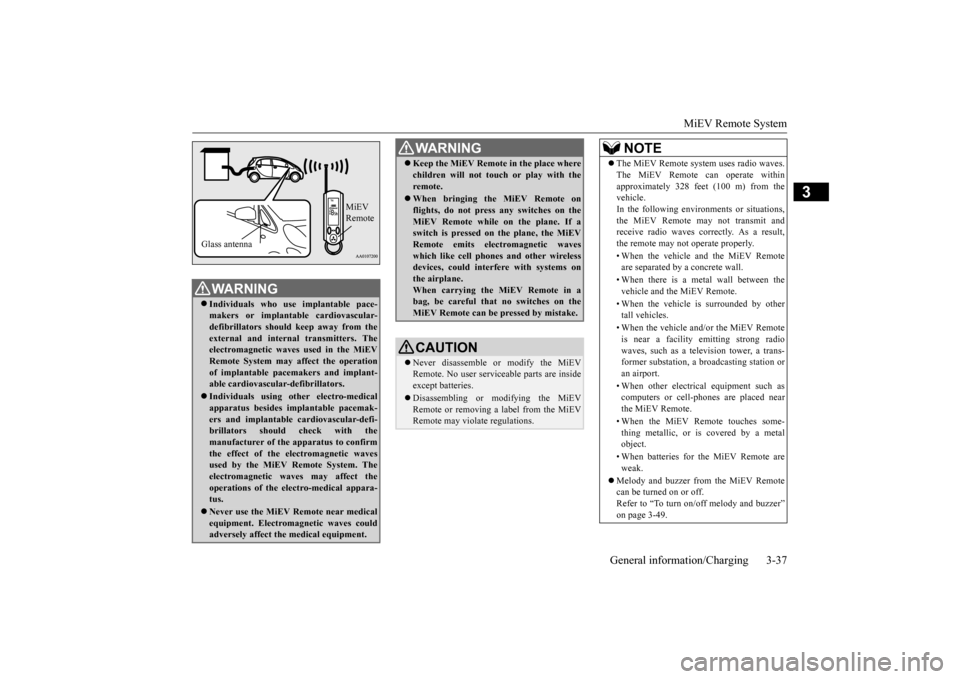
MiEV Remote System
General information/Charging 3-37
3
WA R N I N G Individuals who use
implantable pace-
makers or implanta
ble cardiovascular-
defibrillators
should keep away from the
external and internal
transmitters. The
electromagnetic waves used in the MiEVRemote System may affect the operation of implantable pacemakers and implant- able cardiovascular-defibrillators. Individuals using ot
her electro-medical
apparatus besides implantable pacemak-ers and implantable
cardiovascular-defi-
brillators should
check with the
manufacturer of the apparatus to confirmthe effect of the el
ectromagnetic waves
used by the MiEV Remote System. The electromagnetic waves may affect theoperations of the el
ectro-medical appara-
tus. Never use the MiEV Remote near medical equipment. Electrom
agnetic waves could
adversely affect th
e medical equipment.
MiEV Remote
Glass antenna
Keep the MiEV Remote in the place where children will not touch or play with theremote. When bringing the MiEV Remote on flights, do not press any switches on theMiEV Remote while on the plane. If a switch is pressed on the plane, the MiEV Remote emits electromagnetic waveswhich like cell phones and other wireless devices, could interfere with systems on the airplane.When carrying the MiEV Remote in a bag, be careful that no switches on the MiEV Remote can be pressed by mistake.CAUTION Never disassemble or modify the MiEV Remote. No user servic
eable parts are inside
except batteries. Disassembling or modifying the MiEV Remote or removing a label from the MiEV Remote may violate regulations. WA R N I N G
NOTE
The MiEV Remote syst
em uses radio waves.
The MiEV Remote can operate withinapproximately 328 feet (100 m) from thevehicle. In the following environments or situations, the MiEV Remote may not transmit andreceive radio waves correctly. As a result, the remote may not
operate properly.
• When the vehicle a
nd the MiEV Remote
are separated by a
concrete wall.
• When there is a metal wall between the vehicle and the MiEV Remote. • When the vehicle is surrounded by other tall vehicles. • When the vehicle and/or the MiEV Remote is near a facility
emitting strong radio
waves, such as a television tower, a trans-former substation, a
broadcasting station or
an airport. • When other electrical equipment such as computers or cell-phones are placed near the MiEV Remote. • When the MiEV Remote touches some- thing metallic, or is
covered by a metal
object. • When batteries for the MiEV Remote are weak.
Melody and buzzer from the MiEV Remote can be turned on or off. Refer to “To turn on/
off melody and buzzer”
on page 3-49.
BK0220401US.book 37 ページ 2015年6月3日 水曜日 午前7時42分
Page 52 of 296
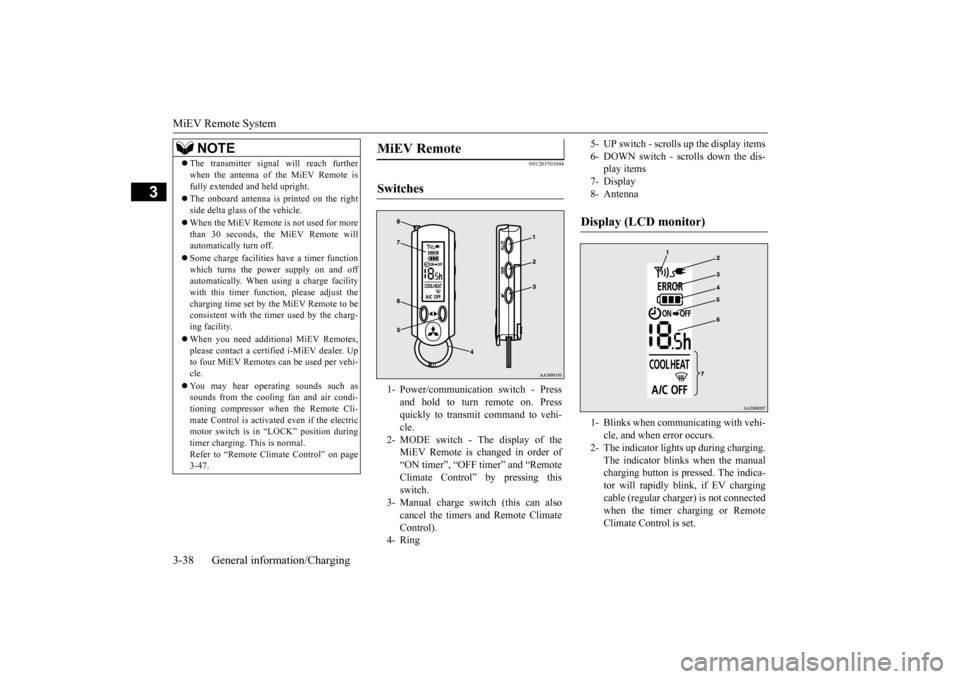
MiEV Remote System 3-38 General information/Charging
3
N01203501044
The transmitter signal will reach further when the antenna of the MiEV Remote isfully extended and held upright. The onboard antenna is printed on the right side delta glass
of the vehicle.
When the MiEV Remote is not used for more than 30 seconds, the MiEV Remote willautomatically turn off. Some charge facilities
have a timer function
which turns the power supply on and off automatically. When using a charge facility with this timer function, please adjust thecharging time set by the MiEV Remote to be consistent with the timer used by the charg- ing facility. When you need additi
onal MiEV Remotes,
please contact a certified i-MiEV dealer. Upto four MiEV Remotes
can be used per vehi-
cle. You may hear operating sounds such as sounds from the cooli
ng fan and air condi-
tioning compressor when the Remote Cli-mate Control is activated even if the electric motor switch is in “LOCK” position during timer charging. This is normal.Refer to “Remote Climate Control” on page 3-47.NOTE
MiEV Remote Switches 1- Power/communication switch - Press
and hold to turn remote on. Pressquickly to transmit command to vehi- cle.
2- MODE switch - The display of the
MiEV Remote is changed in order of “ON timer”, “OFF timer” and “Remote Climate Control” by pressing thisswitch.
3- Manual charge switch (this can also
cancel the timers and Remote Climate Control).
4- Ring
5- UP switch - scrolls
up the display items
6- DOWN switch - scrolls down the dis-
play items
7- Display 8- AntennaDisplay (LCD monitor) 1- Blinks when communicating with vehi-
cle, and when error occurs.
2- The indicator lights up during charging.
The indicator blinks when the manualcharging button is pressed. The indica- tor will rapidly blink, if EV charging cable (regular charge
r) is not connected
when the timer charging or Remote Climate Control is set.
BK0220401US.book 38 ページ 2015年6月3日 水曜日 午前7時42分